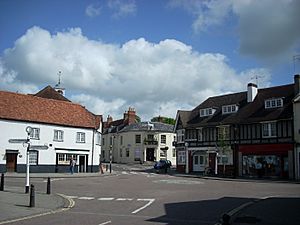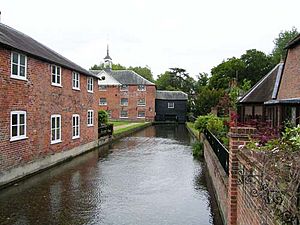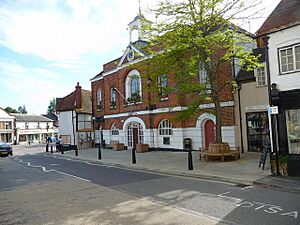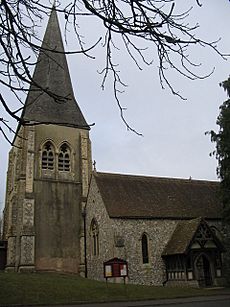Whitchurch, Hampshire facts for kids
Quick facts for kids Whitchurch |
|
|---|---|
 Town Centre of Whitchurch |
|
| Population | 7,198 (2018 Census) |
| OS grid reference | SU465480 |
| District |
|
| Shire county | |
| Region | |
| Country | England |
| Sovereign state | United Kingdom |
| Post town | WHITCHURCH |
| Postcode district | RG28 |
| Dialling code | 01256 |
| Police | Hampshire |
| Fire | Hampshire |
| Ambulance | South Central |
| EU Parliament | South East England |
| UK Parliament |
|
| Website | http://whitchurch.org.uk |
Whitchurch is a lovely town in Hampshire, England. It's located right on the River Test. The town is about 13 miles south of Newbury and 12 miles north of Winchester.
Many parts of Whitchurch are special "Conservation Areas." This means they are protected because of their history and beauty. The River Test and its banks are also a "Site of Special Scientific Interest." This is because of all the amazing wildlife that lives there. Whitchurch is also known as a gateway to the North Wessex Downs National Landscape. This is a huge protected area of natural beauty in Britain.
The town has good transport links. Its railway station connects to London. Two main roads, the A34 and A303, go around the town.
Contents
Whitchurch Through Time
Early Days of Whitchurch
The name "Whitchurch" comes from an old English phrase meaning 'white church'. People have lived here for a very long time, even since the Iron Age. Archaeologists have found old Roman and Iron Age tools, pottery, and even bones.
In 1987, a group found a collection of old gold coins. This was called the Whitchurch Hoard. The earliest written mention of Whitchurch is from the year 909 AD. King Edward the Elder gave the land of Whitchurch to the monks in Winchester. The town also appears in the Domesday Book of 1086. This book recorded details about England after the Norman Conquest.
Growing in the 13th Century
By 1241, Whitchurch was called Witcherche and was becoming successful. It had a market every Monday where people sold things like butter, eggs, and fruit. Markets were very important in medieval times.
Witcherche became a borough in 1284 and received a special royal charter in 1285. This meant it had more rights and was governed by a local group called a Court Leet. The town became even richer because of sheep farming. Wool was a very valuable product back then.
The River Test was important for power. It powered at least four watermills in the town. These mills were used for grinding corn, processing wool, and weaving silk. Today, only the Whitchurch Silk Mill is still standing. It's a popular place to visit, and they still make silk there!
Whitchurch in the 16th Century
When King Henry VIII died in 1547, his young son Edward VI became king. During his rule, England became more Protestant. People in Whitchurch faced difficulties for their religious beliefs. This lasted until Queen Mary I took the throne.
In the 16th century, under Queen Elizabeth I, Whitchurch grew large enough to send two members to Parliament in 1586. For a long time, Whitchurch was known as a "Rotten Borough." This meant that the people who lived there didn't really choose their representatives. Instead, a powerful landowner picked them.
The 18th Century and Paper Making
In 1712, a French refugee named Henri de Portal started a paper mill in Whitchurch. He made very strong and high-quality paper. His paper was so good that the Bank of England started using it for their money. This tradition continues even today! Henri de Portal later became an English citizen. He is buried in All Hallows' Church in Whitchurch. The Whitchurch Town Hall was finished in 1791.
The 19th Century and Public Rights

In 1888, Charles Denning and Clara Thomas moved to Whitchurch. Their son, Alfred Thompson, grew up here and later became a very famous judge, Lord Denning. His house in Newbury Street has a special plaque today.
Towards the end of the 19th century, the Salvation Army held open-air services in Whitchurch. They believed they had the right to do this. However, they were charged with blocking the roads and causing noise. When some of them were found guilty, it led to big protests. In October 1889, 1000 Salvationists protested in the Town Square. They were accused of causing a riot. But a high court ruled in their favor. This ruling helped set laws that protect the public's right to hold peaceful demonstrations.
Whitchurch in the 21st Century
In 2018, Henri de Portal's old paper mill, Bere Mill, was badly damaged by a fire. It had been turned into a family home. Luckily, the mill house was fully repaired by 2020.
All Hallows' Church
The very first church here was a Saxon church. It was called the "white church" because it was built from light-colored stone or chalk. In 1132, the church and its land were given to St Cross Hospital in Winchester.
Not much is known about the first Saxon church. The Norman lords built a bigger church on its site. This is the basis of the current All Hallows' Church. One old Saxon piece that remains is the grave cover of Frithburga. The church was mostly rebuilt in 1866. It has a tall, pointed spire.
All Hallows' Church is a Grade 2* Listed Building. This means it's a very important historical building. It's the oldest building still standing in Whitchurch. The church is also known for its large pipe organ from 1935. It has a set of 10 bells in its tower. The oldest bell is from the 15th century. The bells were made in a field that is now called Bell Street. The church spire is very heavy, weighing 500 tons!
Getting Around Whitchurch
The B3400 road goes through the town. There are also bus services that connect Whitchurch to nearby towns like Andover, Overton, Basingstoke, and Winchester.
The railway station is at the north end of town. You can catch trains to London Waterloo in the east and Exeter St Davids in the west. There used to be another station closer to the town center, but it closed in 1960.
Learning in Whitchurch
Testbourne Community School is a school for students aged 11–16. It was rated "outstanding" in 2010 by Ofsted, which inspects schools. The school focuses on performing arts.
Whitchurch Church of England Primary School is for younger students. It was rated "good" with some "outstanding" features in 2011. The nearest university is the University of Winchester, about 12.5 miles south of Whitchurch.
Fun and Sports in Whitchurch
Whitchurch has a local football club called Whitchurch United F.C.. They play at a place called Longmeadow. At Longmeadow, you can also find a Bowls club and a Squash club with two courts. Whitchurch also has two Cricket teams that play at Parsonage Meadow.
There's a lively amateur theatre group called WADS, which started in 1958. Every year, there's a fun beer festival at the Longmeadow Sports and Social Club.
Whitchurch is great for cycling! It's near the North Wessex Downs Area of Outstanding Natural Beauty. You can find many cycling routes, both easy and challenging, on roads and off-road. Popular routes go to the Bourne Valley and down the Test Valley.
For younger kids, there's a BMX cycle track and a 'Sk8' board area in Daniel Park. This park, along with the open space next to the primary school, is protected as a Queen Elizabeth II field. The Whitchurch Town Council also looks after several children's playgrounds around the town.
Nature in Whitchurch
The River Test that flows through Whitchurch is a special place for nature. It's a Site of Special Scientific Interest because of its unique environment and wildlife.
Much of the land south of the town center used to be old water meadows. One area is managed by the Whitchurch Millennium Green Trust. It has an old dam and a sluice that were used to flood the meadow in the past. There's also a very old wooden sheep dip. Its ponds have special viewing platforms. Old maps show how these areas were fed by natural springs. One important spring still exists at Ninesprings Nursery. It used to feed what are thought to be some of the oldest watercress beds in Britain.
Whitchurch is known as the Gateway to the North Wessex Downs National Landscape. This area has rolling chalk hills, woodlands, and pastures. A National Landscape is a specially protected area. Its natural beauty is considered important enough to be saved for everyone to enjoy. The North Wessex Downs is the third largest National Landscape in Britain.
Whitchurch Wins BT Competition
In 2010, Whitchurch won the BT "Race to Infinity" competition. This meant that homes and businesses in Whitchurch would be among the first rural areas in Britain to get super-fast fiber-optic internet. This brought much faster internet speeds to the town and its surrounding villages.
Famous People from Whitchurch
- Richard Adams, the author of Watership Down, lived in Whitchurch. The real Watership Down is about 6 miles from the town.
- Carl Barât, a musician from the bands The Libertines and Dirty Pretty Things, grew up here.
- King Charles I stayed with the Brooke family in Whitchurch in 1644. The house where he stayed is still there and is called Kings Lodge.
- Lord Denning, a famous English Judge, grew up in Whitchurch.
- James Robertson Justice, an actor, lived in Whitchurch.
- John Hall (1765–1836), a famous engineer and entrepreneur, was born in Whitchurch.
- Charles Kingsley, who wrote The Water Babies, stopped at the White Hart Hotel in Whitchurch.
- Paul Sartin, a folk musician from the band Bellowhead, lived in the town for 20 years.
- Actor Leslie Schofield, known for roles in Star Wars Episode IV and EastEnders, lived in Whitchurch.
- The writer William Wycherley was baptized in Whitchurch in 1641.
See also
 In Spanish: Whitchurch (Hampshire) para niños
In Spanish: Whitchurch (Hampshire) para niños





